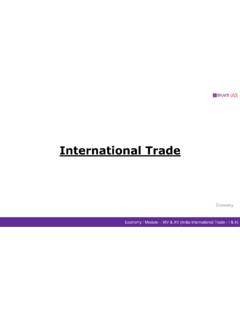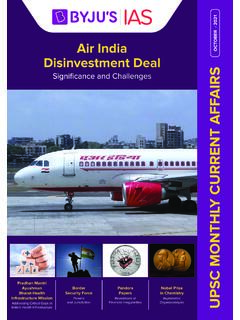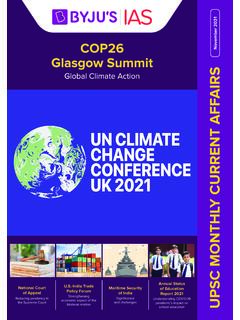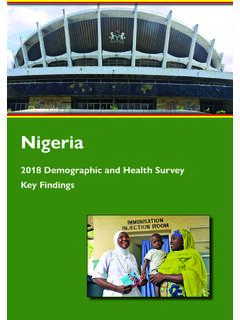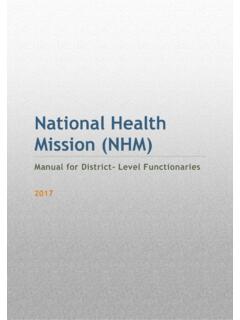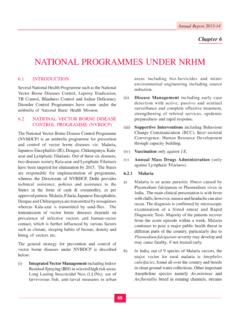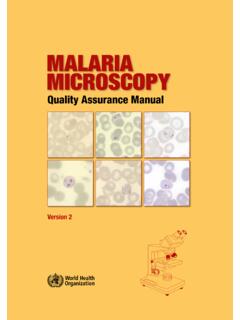Transcription of ENVIRONMENT, SCIENCE & WEEKLY CURRENT TECH …
1 WEEKLY CURRENT AFFAIRSW ebinar HandoutENVIRONMENT, SCIENCE & TECH CURRENT AFFAIRS AND DOWN TO EARTHW ebinar Handout CONTENT ENVIRONMENT, SCIENCE & TECH CURRENT AFFAIRS AND DOWN TO EARTH (DECEMBER 2021) Deaths linked to 2nd highest in India: Study _____ 02-04 World malaria Report 2021 _____ 05-08 World s coldest regions have been on fire in 2021 _____ 09-11 The State of the world s land and water resources for food and agriculture (SOLAW 2021) _____ 12-14 Climate crisis has cost India 5 million hectares of crop in 2021 _____ 15-17 1. Deaths linked to 2nd highest in India: Study Context: The Health Effects Institute (HEI), an independent, non-profit research institute has recently published the study named Global Burden of Disease from Major Air Pollution Sources (GBD MAPS): A Global Approach.
2 It analysed data on air pollution and mortality from 1970 to 2017. Particulate Matter (PM): PM is the term for a mixture of solid particles and liquid droplets found in the air. PM10: Inhalable particles, with diameters that are generally 10 micrometres and smaller. : Fine inhalable particles, with diameters that are generally micrometres and smaller. Figure: Particulate Matter (PM) and size Source: United States Environmental Protection Agency (EPA) Harmful Effects of PM: PM Structural Damage: Particulate matter contains microscopic solid/liquid droplets that are so small that they can be inhaled and cause serious health problems. Causing serious Disease: Some particles less than 10 micrometres in diameter can get deep into the lungs and may also get into the bloodstream.
3 PM causes the greatest damage: Of all the PMs, particles less than micrometres in diameter, also known as fine particles or , pose the greatest risk to health. Increasing Global Deaths: Globally, the number of deaths associated with outdoor exposure increased marginally from 2017 to 2019, the HEI study found. Mains Paper: General Studies 2: Syllabus: Issues relating to development and management of Social Sector/Services relating to Health, Education, Human Resources Important International institutions, agencies and fora, their structure, mandate General Studies 3: Syllabus: Conservation, environmental pollution and degradation, environmental impact assessment Cause of Premature deaths: Another study said higher PM concentrations originating from fossil fuel combustion caused million premature deaths in India in 2018.
4 Regional Deaths: PM released due to burning of fossil fuels contributed to millions of deaths in 2017 worldwide, 80% of which were in South Asia or East Asia. Figure: Estimated deaths from fine particle exposure Source: GBD MAPS: A Global Approach India s scenario: India s PM levels have steadily risen between 2012 and 2018 in most cities. Highest deaths due to PM : India recorded the second-highest deaths in the world due to exposure to PM During COVID-19: Despite a country-wide lockdown in 2020, pollution levels have been higher than most years. The top four areas with the highest concentrations in India are Singrauli, Kanpur, Sitapur, and Ahmedabad. All experienced increase in population-weighted mean (PWM) for mass between 1970 and 2017. Above-average PWM: The PWM for the four places was 14-16 times the annual average advocated in World Health Organisation guidelines.
5 PM Leading Factors as per the study: Fossil fuels are a major source of emissions that are trapped in the atmosphere due to various atmospheric factors. Coal: Of the fossil fuels, coal contributed the most to global deaths associated with particulate matter emissions, the study found. Natural gas and oil combustion: Coal combustion alone was responsible for half of those deaths, while natural gas and oil combustion were responsible for the other half, the study found. The industry sector also contributed to the largest attributable deaths per 100,000 people in North Korea, China, and India. The burning of solid biofuels, such as wood for indoor heating and cooking, is another major source of mostly in South Asia and Sub-Saharan Africa.
6 Other dominant global sources included residential, industrial, and energy sectors, according to the report. Government of India (GoI) Action Plans for Improvement of Air Quality: GoI Launched national Clean Air programme (NCAP) to achieve a 20 % to 30 % reduction in PM10 and concentrations by 2024 keeping 2017 as the base year for the comparison of concentration. Introduction of BS-VI compliant vehicle standard from 2020 for reduction of vehicular pollution which can reduce particulate matter (PM) in vehicles by 80%. Launched a Comprehensive Action Plan (CAP) in 2018 and Graded Response Action Plan (GRAP) in 2017, for Delhi and NCR. A dedicated media corner, Twitter and Facebook accounts have been created for access to air quality-related information and to provide a platform for lodging complaints by the public.
7 Conclusion: Global elimination of fossil fuel: Roughly 1 million (95% UI: million) deaths could be avoided by the global elimination of fossil fuel combustion, with 20% of this burden associated with fossil fuel use in China and India alone. Complete elimination of coal in China and India could reduce the global disease burden by nearly 20 percent, the study suggested. Integration of Methods: The researchers called for integrating air quality, energy, and climate policies to bring about substantial health benefits. Q1. With reference to the recently published study Global Burden of Disease from Major Air Pollution Sources (GBD MAPS): A Global Approach , consider the following statements: 1. India recorded the highest number of deaths in the world due to exposure to PM 2.
8 Singrauli is among the top four areas with the highest concentrations in India. 3. Due to a country-wide lockdown, the pollution levels in India in 2020 have been the lowest ever. Which of the statements given above is/are incorrect? (a) 1 and 3 only (b) 2 only (c) 3 only (d) 1 and 2 only Answer: (a) Explanation: The Health Effects Institute (HEI), an independent, non-profit research institute has recently published the study named Global Burden of Disease from Major Air Pollution Sources (GBD MAPS): A Global Approach. Statement 1 is incorrect: India s PM levels have steadily risen between 2012 and 2018 in most cities. India recorded the second-highest deaths in the world due to exposure to PM , the report said. Statement 2 is correct: As per the report, the top four areas with the highest concentrations in India are Singrauli, Kanpur, Sitapur, and Ahmedabad.
9 All experienced increase in population-weighted mean (PWM) for mass between 1970 and 2017. The PWM for the four places was 14-16 times the annual average advocated in World Health Organisation guidelines. Statement 3 is incorrect: Despite a country-wide lockdown in 2020, pollution levels have been higher than most years. Q2. PM exposure has now become a great cause of concern for the global mankind. Enumerate the challenges posed due to this fine particle matter and suggest some measures to deal with it. (10 Marks, 150 Words) 2. World malaria Report 2021 Context: Recently, the World malaria Report 2021 was released by the World Health Organisation (WHO). About the World malaria Report: WHO releases the World malaria report annually to provide in-depth information on the latest trends in malaria control and elimination , highlight the progress towards global targets and analyse the challenges.
10 This year s report includes a special analysis on the impact of disruptions to malaria prevention, diagnosis, and treatment during the COVID-19 pandemic. Global trends in the Burden of malaria : Globally, the number of cases increased from 227 million in 2019 to an estimated 241 million malaria cases in 2020, in 85 malaria -endemic countries. The proportion of cases due to Plasmodium vivax reduced from about 8% in 2000 to 2% in 2020. Twenty-nine countries accounted for 96% of malaria cases globally. Regional trends: o The WHO African Region accounted for 95% of global malaria cases in 2020. o The WHO South-East Asia Region accounted for about 2% of the burden of malaria cases globally. o The WHO Eastern Mediterranean Region saw a reduction in malaria cases by 38%, o The WHO Eastern Mediterranean Region has seen a decline in malaria cases from 21 to 11 cases per 1000 population at risk o The WHO Western Pacific Region witnessed a decrease of 39% from total cases in 2000.

